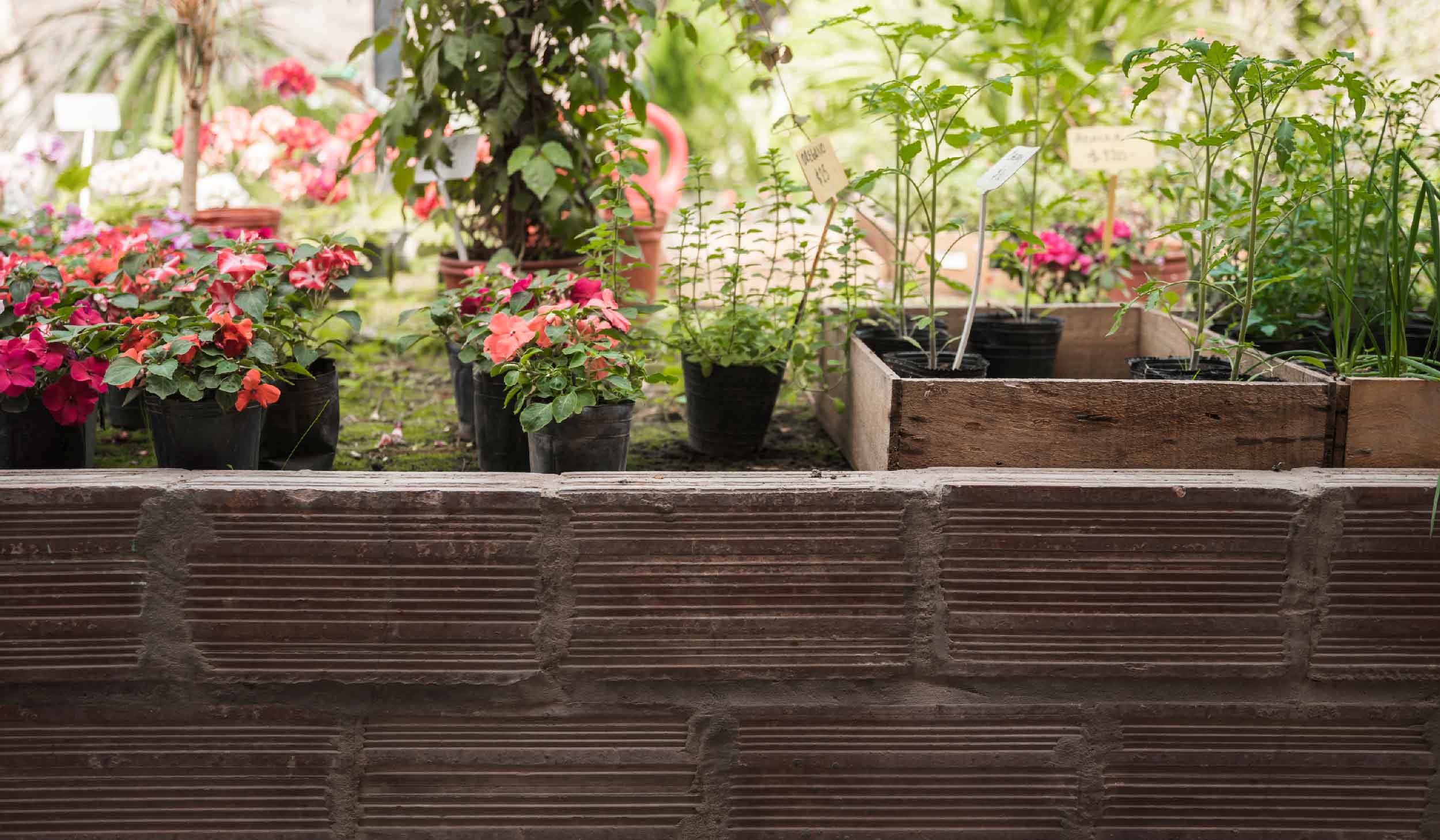What is Terrace Gardening?
Terrace Garden is a wonderful way to bring greenery, relaxation, and even productivity into your living space. Terrace garden design is the process of creating a special garden in your personal space, often on the rooftop or balcony of your home. This design involves utilizing available space to grow plants, flowers, and even vegetables, creating a green oasis that enhances the beauty and tranquility of your living environment. It combines creativity and functionality to transform underutilized spaces into vibrant, lush gardens, providing a perfect retreat within the comfort of your home.
Terrace Garden Design for Beginners: Whether you have a small balcony or a spacious rooftop terrace, creating a garden in these urban settings allows you to explore gardening without needing a traditional yard. It’s a chance to cultivate plants, grow your herbs or vegetables, or simply create a serene outdoor retreat right at home.
Terrace garden design offers unique opportunities and challenges compared to ground-level gardens. They often have limited space, varying sunlight exposure, and considerations for weight and water drainage. However, with careful planning and the right approach, these challenges can be turned into creative opportunities.
This Blog will walk you through practical methods and beginner-friendly ideas to properly design and maintain your home terrace garden. Every step of the process—from measuring your area and picking out plants to creating designs, picking out containers, and caring for your garden—will be designed to give you the confidence to build a stunning and flourishing terrace garden that complements your tastes and way of life. This guide tries to inspire and lead you through the fascinating experience of terrace gardening ideas, whether your vision is a colourful flower garden, a cosy herb corner, or a compact vegetable garden.
How to Create a Terrace Garden: A Step-by-Step Guide
Follow these steps to design and maintain a thriving terrace garden:
Step 1: Modern terrace garden design: Assess Your Space
Measure your terrace: Measuring your terrace is the essential first step in designing a successful terrace garden. Here’s why it’s important and how to go about it:
Importance of Measuring Your Terrace
Understanding the dimensions of your terrace allows you to make efficient use of every inch of available space. This helps in planning where to place containers, seating areas, and pathways.
Different plants require different amounts of space for healthy growth. By knowing your terrace’s size, you can choose plants that fit well without overcrowding or underutilizing the space.
Measuring helps in designing for accessibility and ease of maintenance. You can plan for pathways and access points to reach all parts of your garden comfortably.
Terraces have weight limits, and knowing the dimensions helps in calculating the weight-bearing capacity for containers, soil, and plants, which will make it easy to design terrace gardening.
How to Measure Your Terrace for Home Terrace Garden
Grab a measuring tape,pen, and paper or a notebook to take measurements.
Start by measuring the length and width of your terrace. Measure each side accurately from end to end.
Identify any obstacles like pillars, walls, or protruding features that may affect the layout of your garden.
While measuring, note areas that receive full sun, partial sun, or shade at different times of the day. This information will help in selecting plants later.
Create a simple sketch or diagram of your terrace to start your modern terrace garden design. Start marking down the measurements and any relevant features. It will serve as a reference when planning your garden layout.
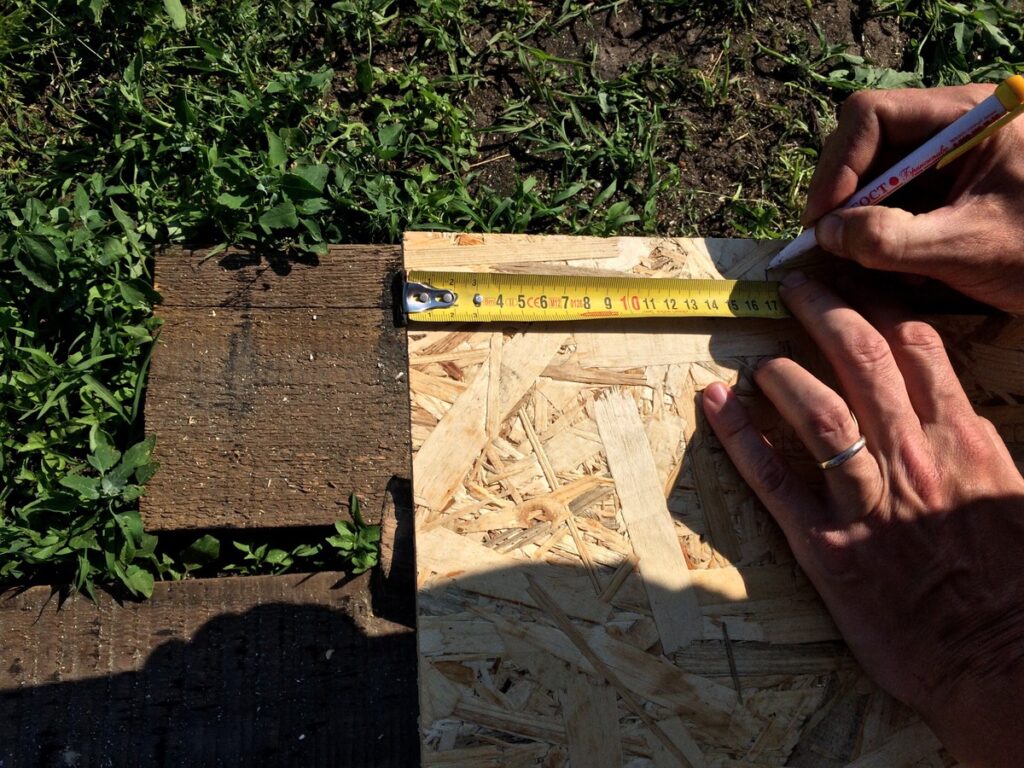
Planning Measurements
Once you have measured your terrace and noted down all relevant details,you can start envisioning how you want to utilize the space:
For Terrace garden design, Plan where you want to place different elements, such as planters, seating areas, pathways, and decorative features.
Based on your measurements, you can determine how many containers or raised beds you can accommodate for an open terrace garden and where to place them for optimal sunlight exposure and aesthetic appeal.
Ensure that your design takes into account practical considerations such as access to water sources, drainage, and any structural limitations of your terrace.
By taking the time to measure your terrace thoroughly, you set a solid foundation for creating a terrace garden that is both functional and visually appealing. It allows you to make informed decisions at each step of the design process, ultimately leading to a well-planned and enjoyable outdoor space tailored to your preferences.
Step 2: Terrace garden design ideas: Set Goals and Themes
Setting goals and choosing a theme for your terrace garden are crucial steps that help define its purpose and guide your design and plant selection.
Define Your Goals
Setting goals and choosing a theme for your terrace garden are crucial steps that help define its purpose and guide your design and plant selection.
Start by considering your vision for a terrace garden. Which one are you going to grow, vegetables or fruits? Do you want a space to relax and unwind after a long day? Are you aiming to enhance the aesthetic appeal of your home with greenery?
Think about how you will use the space. Will you entertain guests there, or is it primarily for personal enjoyment? Understanding these goals will shape how you plan the layout and what features you incorporate in the terrace garden.
Assess if there are specific functions your garden needs to fulfil, such as providing shade, improving air quality, or attracting pollinators like butterflies and bees.
Determine how much time and effort you can realistically devote to maintaining your garden. This will influence your plant choices and overall terrace gardening design complexity.
Choose a Theme

A herb garden theme focuses on growing culinary herbs like basil, rosemary, mint, and thyme. It’s practical for cooking enthusiasts and adds fragrance and utility to your terrace.
This theme emphasizes blooming flowers, creating a vibrant and colourful space. You can choose a colour scheme or mix various types of flowers for continuous blooms throughout the season.
Succulents are low-maintenance and come in various shapes and sizes. A succulent garden theme can create a modern, minimalist look with a focus on drought-tolerant plants.
Incorporating a mix of herbs, flowers, and perhaps even vegetables allows for versatility and can cater to different interests. This theme provides both beauty and functionality.
How Themes Guide Your Garden Design
Each theme dictates the types of plants you’ll include. For example, a herb garden will prioritize herbs that thrive in containers and enjoy sun exposure. A succulent oasis will feature plants that require well-draining soil and minimal water.
Themes help you create cohesion in your garden design by selecting plants that complement each other in terms of colour, texture, and growth habits.
Whether you prefer a lush, green sanctuary or a burst of colourful blooms, choosing a theme ensures your terrace garden reflects your style and enhances the overall aesthetics of your outdoor space.
Different themes have varying maintenance needs. Understanding these upfront helps you plan for watering, pruning, and fertilizing according to the specific requirements of your chosen plants.
Step 3: Home Terrace garden design ideas: Select Plants
Consider Local Climate and Conditions
Research the climate zone and microclimate of your specific location. Consider factors such as temperature fluctuations, humidity levels, and average rainfall. This knowledge helps you select plants that are well-suited to thrive on your terrace.
Assess the amount of sunlight your terrace receives throughout the day and how windy it gets. Choose plants that can tolerate these conditions. For instance, wind-tolerant plants may include ornamental grasses or certain succulents, while sun-loving plants like herbs and flowering annuals thrive in full sun.
If your region experiences extreme temperatures, select plants that can withstand these fluctuations. Look for hardy varieties that can handle both hot summers and potentially cold winters if your terrace garden is active year-round.
Terraces often have limited soil depth and drainage capabilities. Opt for plants that are suitable for containers or raised beds with well-draining soil mixes. This ensures healthy root growth and reduces the risk of waterlogging.
Choose a Variety of Plants
Incorporate plants of varying heights to create visual interest and depth. Tall plants such as bamboo or small trees can provide vertical accents, while medium-height plants like shrubs or flowering perennials fill the mid-level, and ground covers or trailing plants cascade over the edges.
Mix plants with different leaf textures (smooth, rough, glossy) and forms (round, spiky, feathery). This diversity adds dimension to your garden and creates a rich visual tapestry.
Consider a color scheme or mix of complementary colors to unify your garden design. For example, you might choose a harmonious blend of cool blues and purples for a calming effect or vibrant yellows and oranges for a cheerful ambience.
Choose plants that provide year-round seasonal interest. Include evergreens for year-round greenery, flowering plants for seasonal blooms, and foliage plants with interesting textures or colors even when not in bloom.
Aim to create a balanced ecosystem by including plants that attract beneficial insects like bees and butterflies. Native plants often support local wildlife and require less maintenance once established.
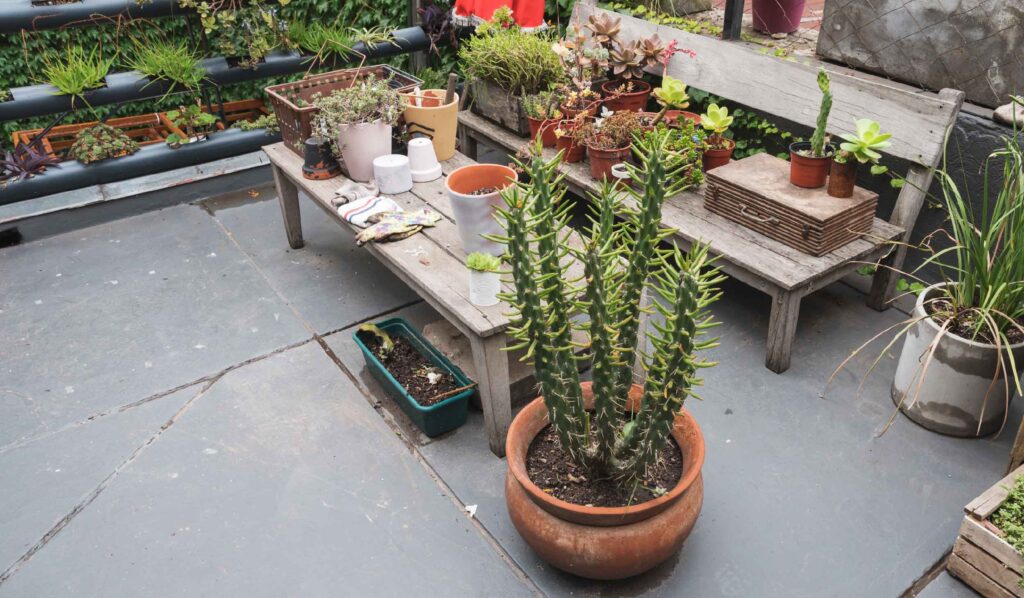
Practical Tips for Plant Selection
- Read Plant Labels: Pay attention to plant tags or labels for information on sun requirements, water needs, and mature size.
- Consult Local Experts: Visit local nurseries or garden centers for advice on plants that thrive in your area’s specific conditions.
- Trial and Observation: Experiment with a variety of plants initially to see how they perform on your terrace. Observe their growth and adapt your selection based on their success.
By carefully selecting plants that are well-adapted to your terrace’s climate and conditions while incorporating a diverse mix of heights, textures, and colors, you can create a vibrant and resilient garden space that enhances your outdoor living experience. This thoughtful approach ensures your terrace garden design ideas not only look beautiful but also thrive in its environment over the long term.
Step 4: Organic terrace gardening: Containers and Soil
Select Containers
By selecting containers with proper drainage and suitable size and using a quality potting mix enriched with compost, you create an optimal environment for your terrace garden plants to thrive.
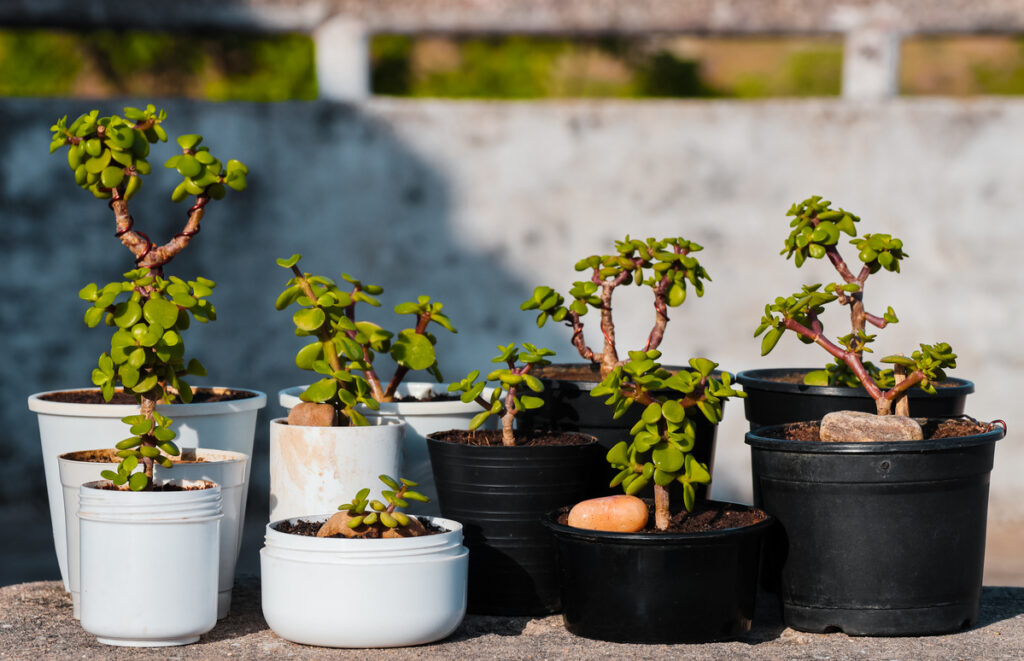
Choose containers that have adequate drainage holes at the bottom. In order to avoid waterlogging, which can cause root rot and other problems with plant health, proper drainage is essential.
Select containers that are spacious enough to accommodate the root systems of your plants as they grow. Smaller containers may require more frequent watering and can restrict root growth, affecting plant health.
Opt for lightweight materials like plastic, fibreglass, or resin if weight is a concern, especially for elevated terraces or balconies. Alternatively, ceramic and clay pots provide a more aesthetic appeal but are heavier and may require more careful handling.
Choose the Right Soil
Make use of a premium potting mix that has been specially designed for container gardening. Potting mixes are lighter than garden soil and provide better aeration and drainage, which are essential for healthy root development in containers.
Look for potting mixes that contain a blend of materials like peat moss, perlite, vermiculite, and composted bark. These components ensure good water retention while allowing excess water to drain away efficiently.
Consider mixing in compost or organic matter to enrich the potting mix with nutrients. This promotes healthier plant growth and reduces the need for frequent fertilization.
Garden soil is not suitable for containers as it tends to compact in confined spaces, leading to poor drainage and root suffocation.

Additional Tips
- Container Maintenance: Regularly check containers for clogged drainage holes and prune roots if they outgrow the container.
- Watering: Containers dry out faster than garden beds, so monitor soil moisture regularly and water as needed, especially during hot weather.
- Overwintering: In colder climates, consider insulating containers or moving them to a sheltered location to protect plants from frost damage.
These steps ensure that your plants have adequate space for root growth, sufficient nutrients, and the right balance of moisture—a recipe for healthy and vibrant container gardens.
Step 5 :Terrace Garden design ideas :Maintenance and Care
Watering

Different plants have varying water requirements based on factors like species, container size, and environmental conditions. Research each plant’s watering needs to avoid overwatering or underwatering.
Installing a drip irrigation system can automate watering and ensure plants receive consistent moisture levels. This is especially beneficial for terrace gardens, where plants can dry out quickly due to exposure to sun and wind.
Consider using self-watering pots equipped with a reservoir that allows plants to draw water as needed. These pots help maintain soil moisture levels more evenly, reducing the frequency of manual watering.
Regularly check soil moisture by inserting your finger into the soil or using a moisture meter. Water thoroughly when the top inch or two of soil feels dry, ensuring water penetrates to the root zone.
Fertilizing
Use organic fertilizers to feed your plants regularly. These fertilizers release nutrients slowly and improve soil structure over time, promoting long-term plant health.
Follow the recommended application rates on fertilizer labels. Generally, fertilize container plants more frequently than those in garden beds because nutrients can leach out with watering.
Choose fertilizers formulated for container plants, such as balanced blends (e.g., 10-10-10) or speciality formulations tailored to specific plant needs (e.g., high nitrogen for leafy vegetables).
Pest and Disease Control
Inspect plants regularly for signs of pests (e.g., aphids, spider mites) or diseases (e.g., powdery mildew, fungal infections). Early detection allows for prompt intervention.
Organic pest control methods are preferred to minimize chemical exposure and maintain ecological balance. Options include insecticidal soaps, neem oil, or homemade remedies like garlic spray for pests.
Encourage plant health through proper spacing, adequate sunlight, and good air circulation. Pests and diseases are less likely to affect healthy plants.
Implement IPM strategies, which combine preventive measures, monitoring, and appropriate interventions as needed. This approach minimizes pesticide use while effectively managing pest problems.
Additional Tips & Ideas for Home Terrace Garden Design
- Pruning and Deadheading: Regularly prune dead or damaged plant parts and deadhead spent flowers to promote new growth and maintain plant vigour.
- Seasonal Adjustments: Adjust maintenance practices seasonally. For example, reduce watering and fertilizing during winter months when plant growth slows.
- Record Keeping: Keep a garden journal to track watering schedules, fertilization dates, pest occurrences, and successful treatments. This helps optimize care strategies over time.
By understanding and addressing the watering, fertilizing, and pest control needs of your terrace garden, you create an environment where plants thrive and remain healthy throughout the growing season. Consistent care and proactive management ensure your garden not only survives but flourishes, providing enjoyment and satisfaction for you as a gardener.
Step 6:Roof Garden Design: Accessories and Décor
Add Personal Touches
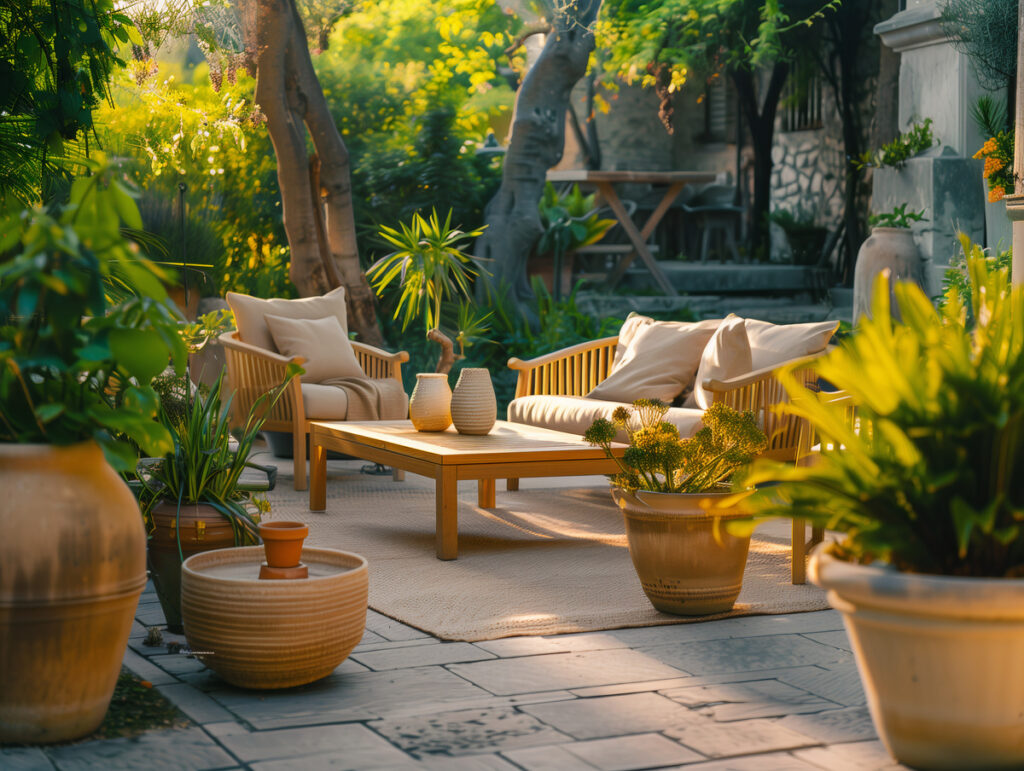
Choose comfortable seating options such as chairs, benches, or even a small bistro set where you can relax and enjoy your terrace garden. Opt for weather-resistant materials like rattan, aluminum, or treated wood.
Enhance the ambience of your terrace garden with strategic lighting. Use string lights, solar-powered lanterns, or LED spotlights to create a cosy atmosphere for evening enjoyment. Consider installing pathway lights for safety and aesthetics.
Personalize your space with decorative elements such as colorful cushions, outdoor rugs, wind chimes, or artwork. These add character and reflect your style while complementing the greenery of your garden.
If space permits, consider adding a small water feature like a fountain or a miniature pond. The sound of flowing water can create a soothing atmosphere and attract birds and beneficial insects.
Use Space Creatively
Hang planters, trellises, or shelves can be installed to make use of available vertical space. Vertical gardening not only maximizes planting space but also adds visual interest and texture to your terrace.
Hang baskets from railings or overhead structures to showcase trailing plants like ivy, ferns, or flowering vines. This technique adds layers of greenery and color without taking up valuable floor space.
Upcycle wooden pallets to create vertical gardens or planters. Securely attach pots or containers to the pallets and lean them against a wall or fence. This DIY approach provides a rustic charm and expands planting opportunities.
Choose furniture pieces that offer storage options, such as benches with built-in storage compartments or coffee tables with hidden storage. This helps maximize space while keeping gardening tools or extra cushions neatly tucked away.
Additional Tips & Ideas for Home Terrace Garden Design
- Seasonal Décor: Change decorative elements seasonally to celebrate holidays or adapt to changing weather conditions. For example, add festive decorations during holidays or swap out cushions for warmer or cooler seasons.
- Functional Design: Ensure that accessories and décor items not only enhance aesthetics but also serve functional purposes. For instance, incorporate plant stands that double as storage or use decorative pots that complement your plant selection.
- Safety Considerations: If adding lighting or water features, prioritize safety by ensuring proper installation and using weatherproof materials. Check local regulations regarding electrical installations if necessary.
By incorporating personal touches and using space creatively, you transform your terrace garden into a welcoming oasis that reflects your style and enhances outdoor living. These elements not only beautify your space but also contribute to its functionality and enjoyment throughout the year.
Step 7: Final Step to your Terrace Garden: Enjoy & Learn
Observe and Learn
Regularly observe how your plants respond to the conditions on your terrace—sunlight exposure, watering frequency, soil quality, etc. Note any signs of stress, such as wilting leaves or discolouration, which can indicate issues with watering or nutrient levels.
Pay attention to how plants change throughout the seasons. Some may bloom profusely in spring but require extra care in hot summers or protection from frost in winter. Adjust your gardening practices accordingly.
Treat your terrace garden as a living experiment. Try different plant combinations, watering schedules, or placement strategies to see what works best for your specific environment and preferences.
Take Advantage of gardening books, online forums, and local gardening clubs to expand your knowledge. Exchange tips with other gardeners and learn from their experiences to improve your gardening skills.
Celebrate the Success
- Enjoy the Beauty: Take time to appreciate the beauty of your terrace garden. Whether it’s the vibrant colors of blooming flowers, the fresh aroma of herbs, or the calming presence of greenery, savor the visual and sensory delights your garden offers.
- Harvest Rewards: If you’re growing edible plants like herbs or vegetables, celebrate the rewards of your efforts by harvesting fresh produce for culinary delights. There’s a special satisfaction in enjoying homegrown ingredients in your meals.
- Share Your Garden: Invite friends and family to experience your terrace garden. Share stories about your gardening journey, from planting seeds to nurturing growth, and showcase the unique features and plants you’ve chosen.
- Learn from Challenges: Embrace challenges as opportunities to learn and improve. If plants struggle or pests appear, view these setbacks as valuable lessons in understanding your garden’s needs better and implementing effective solutions.
Conclusion
In conclusion, embarking on the journey of creating a modern terrace garden idea is not only about cultivating plants but also about transforming your outdoor space into a thriving oasis of beauty and functionality. By following the steps outlined—from measuring your beginners can easily transform the terrace and also setting goals to selecting plants, maintaining your garden with care, and adding personal touches—you can design a terrace garden that reflects your style and enhances your lifestyle.
As you observe and learn from your plants’ responses to different conditions, celebrate the successes of your gardening efforts. The Advantage of terrace gardening is that you’ll find joy in the beauty and satisfaction of nurturing your green haven. Whether you choose a herb garden, floral paradise, or a blend of various themes, your terrace garden becomes a personalized retreat that enriches your daily life.

